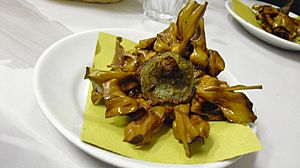Carciofi alla giudia facts for kids
Carciofi alla giudìa is a very famous dish from Rome. Its name means "Jewish-style artichokes." This special recipe comes from the Jewish community in Rome.
The dish is basically an artichoke that has been deep-fried. It's a popular food in the Roman Ghetto, which is a historic Jewish neighborhood in Rome. You can often find it served in Jewish restaurants there, especially in the springtime.
Contents
How to Make Carciofi alla Giudìa
Choosing the Best Artichokes
For this dish, the best artichokes are a type called Romanesco. These artichokes are picked between February and April. They grow in the coastal area northwest of Rome, near towns like Ladispoli and Civitavecchia.
Step-by-Step Preparation
First, the artichokes are carefully cleaned. You use a sharp knife to remove all the tough outer leaves. This is done with a spiral motion.
Next, the cleaned artichokes are gently hit together. This helps to open up their leaves. They are then placed in water with lemon juice for a few minutes. The lemon juice stops them from turning black.
After that, the artichokes are seasoned with salt and pepper. Then, they are deep-fried in olive oil until they are golden brown.
The final step is to sprinkle a little cold water on them. This makes them extra crispy. When they are ready, they look like small, golden sunflowers. Their leaves become crunchy and have a nutty taste. Carciofi alla giudìa are always eaten warm.
A Special Discussion About Artichokes
In 2018, there was a discussion about artichokes and traditional food rules. Some people wondered if artichokes could always follow strict dietary guidelines. This was because the dense leaves might hide tiny insects.
However, the Jewish community in Rome had a strong opinion. They argued that the artichokes used for this dish have very tight leaves. They believed this meant insects could not get inside. This dish is very important to their culture and history. It has deep roots in the Italian Jewish community.
See also
 In Spanish: Alcauciles a la judía para niños
In Spanish: Alcauciles a la judía para niños


